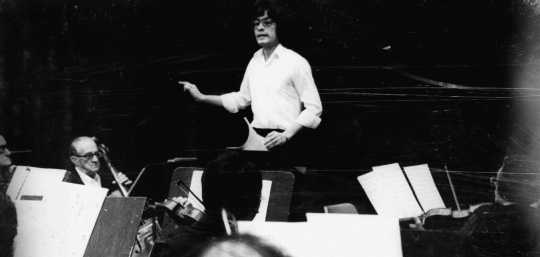|
Soundtrack composers from Ennio Morricone to Piero Umiliani or Ryuichi Sakamoto to Lalo Schifrin have all used their scoring opportunities to mix genres into undescribable blends, practically creating new musical subgenres during the process. Freaky, acid grooves find themselves nudging up alongside choirs, symphonic percussion, odd drones, field recordings, and noise in these composers’ most challenging scores.
All of which connects them to the work of Peru’s Luis David Aguilar, a prolific musician and composer who wrote music for television shows, advertisements, and film. Aguilar, whose work blends the avant-garde with classical composition and some of Peru’s native traditions, was one of a number of Peru’s more experimental film composers, such Walter Casas and Seiji Asato, coming to prominence in the 1970s. And if you’ve paid attention to other releases Buh has presided over in recent years, you know the country had a sizeable, if previously overlooked experimental music scene at the time.
Ayahuasca contains three tracks, the first of which is a 19 plus-minute long “El Viento del Ayahuasca,” which formed the basis for the film of the same name, released by the Cuban Institute of Cinematographic Art and Industry (ICAIC) in 1983. Featuring the National Orchestra and Choir of Cuba, it was apparently played without rehearsal, which seems impossible upon listening. Sound tracking travels into the jungle to connect with a shaman, it reaches lofty peaks of full band and choir, but also gives way for sections of solo, electronically enhanced piano, unsettling percussion rattles, foreboding kettle drums, and sweeping strings slightly resembling Les Baxter’s Ritual of the Savage, though devoid of the hackneyed attempts to capture “the exotic”.

|
|
The most interesting track of the three is “Anónimo Cotidiano,” which features Aguilar’s own analog synth. At 13 minutes, it shifts tone constantly but never jarringly, with Aguilar’s playing conjuring outer-space blips, calming drones, or counterpoints to Peruvian charango and bombo. Sometimes eerily atonal, sometimes wistful, it’s ultimately a meditation on what the city of Lima sounds like.
“Los Constructores” is the most conventionally “Latin” track here, complete with driving timbales, anchoring bass lines, and a piano delivering the melody as horns and flute punch in and out. What might be considered salsa serves as a type of ballet behind a film featuring the repetitive labor of civil construction workers.
With Ayahuasca, Buh unearths yet more music that continues to demonstrate how rich Peru has been in sounds far beyond its more well-known Andean rhythms or coastal Afro-influenced dance music. This release also serves as a companion to Hombres, a 2015 Buh release of Aguilar’s music. Both of these collections serve to help rescue his music from obscurity.
|
